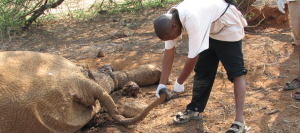Tracking elephant diet by tail hair isotopes

PHOTO CREDIT: © STE FILE
Press Release
Save the Elephants is pleased to announce the publication of the results of a collaboration between our Kenya based conservation body and Dr Thure Cerling of Utah University. The paper describes a novel technique for measuring carbon isotopes in elephant tail hairs that reconstructs what individual elephants have been eating over the course of several years. It is combined with very precise radio-tracking of the same elephants using GPS technology. The finding will be published as a scientific paper in the Jan. 3-6, 2006, online edition of the journal Proceedings of the National Academy of Sciences, and in the journal’s Jan. 10 print issue. Dr Thure Cerling, is a pioneer in the technique of monitoring isotopes in the diet of both live and extinct animals. Our collaboration has not only brought this technique to Kenya, but Dr Cerling has trained local personnel in its application. For full details please read the attached press release from the University of Utah.
Iain Douglas-Hamilton wrote “Dr Thure Cerling has introduced a high tech means of analyzing animal diets from carbon isotopes, and has trained Kenya staff in this technique.
Tracking stable isotopes in an elephant’s diet when combined with actual tracking of movements using high tech remote sensing provides a powerful new tool for conservationists. It allows us to understand possible elephant motivation and from this to see how management plans can be focused on understanding their basic needs for space. One big question is how can we secure a future for elephants when we know that the areas set aside for their protection are too small. Since they need space to roam and since the human population is increasing within elephant range there is inevitable conflict. Tracking an elephant’s diet through stable isotopes defines essential elephant dietary needs and can help inform land use planning. In Northern Kenya it is recognized that wildlife can provide a supplementary and vital income and help alleviate poverty, but careful planning is needed to decide which areas to protect for wildlife and where humans can expand without degrading ecosystems. The fine information from the isotope and actual elephant tracking can help us define the critical minimum space needed by elephants and other animals”
Embargoed by the journal Proceedings of the National Academy of Sciences for release at 3 p.m. MST Monday Jan. 2, 2006
—
Contacts:
— Thure Cerling (first name pronounced Tur-ee), distinguished professor of geology and geophysics, and biology – cellular (801) 864-2554, office (801) 581-5558, [email protected] or [email protected]
— Iain Douglas-Hamilton, Save the Elephants Foundation – cellular only through Dec. 31, (+254) 722 204 868, then at Save the Elephants in Nairobi (+254) 20 891673, [email protected]
— Lee Siegel, science news specialist, University of Utah Public Relations – office (801) 581-8993, cellular (801) 244-5399, [email protected]

